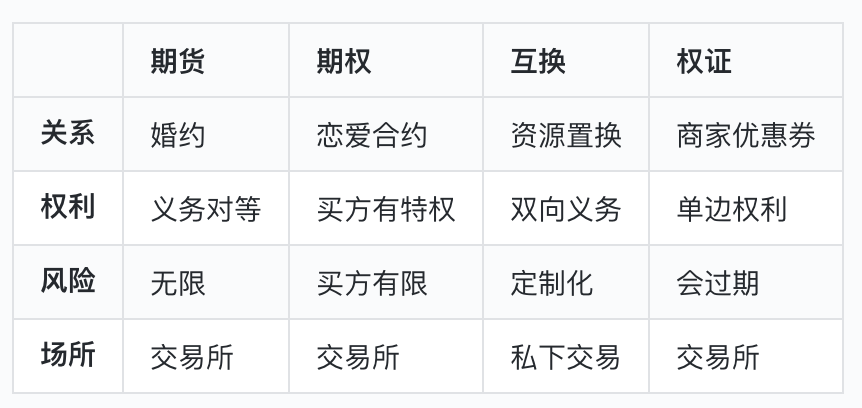1. The Fantastic Four of Finance
If the financial market is likened to a martial arts world, then the financial derivatives family is the most mysterious martial arts sect. Today we will get to know the four core members:
Big 1 futures: a burly straight man who always keeps his word Big 2 options: a flexible tactical master who is good at leaving a way out Big 3 swaps: a low-key behind-the-scenes operator who specializes in resource swaps Big 4 warrants: a small follower of listed companies and a professional coupon issuer
They have one thing in common: they are all "future contracts" - they do not trade current goods, but bet on future prices. Just like when you go to a milk tea shop and buy a "tomorrow's pickup voucher", you pay today to lock in tomorrow's price, regardless of whether the raw material price will increase tomorrow.
2. Get to know each family member
1. Futures: Iron Man always keeps his word. Classic scene: Mr. Wang, who grows wheat, signed a contract with the flour mill in March: “I will sell you 10 tons of wheat at 5 yuan per catty on June 1st”, and both parties paid a 10% margin (equivalent to a deposit).
Three major features:
Forced performance: Delivery/receipt of goods must be made upon maturity. Violation of the contract will lead to pursuit by the underworld (forced liquidation of positions).
Symmetrical risk: When wheat price rises to 6 yuan, Mr. Wang loses 10,000 yuan; when wheat price falls to 4 yuan, the flour mill spends 10,000 yuan more.
Daily settlement: The exchange settles accounts every night, and if the margin is insufficient, you have to pay more (like a class teacher checking homework every day)
Real-world application: Oil companies use crude oil futures to hedge against oil price fluctuations, and every bucket of instant noodles you eat is made possible by futures.
2. Options: Zhuge Liang's classic scenario: Xiao Li spends 500 yuan to buy the right to "buy a school district house for 3 million yuan in one month". If the house price rises to 3.2 million yuan, he will make a net profit of 195,000 yuan (3.2 million yuan - 3 million yuan - 5,000 yuan); if it falls to 2.8 million yuan, he will lose at most 500 yuan.
Three major features:
Asymmetric rights: buyers can lie back, but sellers must work
Insurance premium logic: Buying a property right is like buying insurance for the property price
Non-linear returns: you can earn ten times as much, but the most you lose is your principal.
Contrasting memories: Futures are like getting married (must get a marriage certificate), options are like falling in love (come if you are compatible, leave if you are not).
3. Swap: A classic scenario of underground transactions of resource replacement: Coca-Cola issues Euro bonds in Europe, PepsiCo issues US dollar bonds in the United States, and the two companies privately swap debts - just like academic elites swapping homework, each taking what they need.
Classic gameplay:
Interest rate swap: fixed rate for floating rate
Currency swap: US dollars for euros to avoid exchange rate risks
Commodity swaps: Oil companies trade crude for airline fuel
Industry secret: Multinational corporations use swaps to hedge more than 50% of their foreign exchange risks, but they never include this in their financial reports.
4. Warrants: “Discount coupons” issued by listed companies. Classic scenario: Tencent issued warrants: “One year later, you can use this coupon to buy 1 share of Tencent stock for HK$320.” The current stock price is HK$300, and the warrant price is HK$25.
Two major factions:
Call Warrant: Call Coupon (similar to option buyer)
Put Warrant: A bearish insurance policy (similar to an option seller)
A bitter lesson: In 2007, China Merchants Bank’s put warrants caused countless middle-aged women to lose all their money, simply because they did not know that the warrants would expire and become invalid!
3. One table to understand the differences between the four brothers

4. Why do we need this family?
Price discovery: The futures market can predict pork prices six months later
Risk management: Airlines lock in fuel costs with crude oil options
Arbitrage opportunities: Discover the price difference between CSI 300 Index Futures and ETFs
Speculation tool: Using warrants to achieve "small funds to leverage big returns"
Beware of traps: These tools themselves are not evil, but don’t be like a state-owned enterprise that suffered a huge loss of 46 billion yuan in crude oil futures in 2008 - whether you use a kitchen knife to cut vegetables or chop people depends entirely on the hand holding the knife!
5. Next Issue Preview
Tomorrow we will delve deeper into "The Core Value of Options in Risk Management"
After-class task: Open the stock trading software and look for real-time quotes for futures/options/warrants (Hint: for futures, look at rebar, for options, look at 50ETF, and warrants have basically been delisted) and feel the real transaction data!











